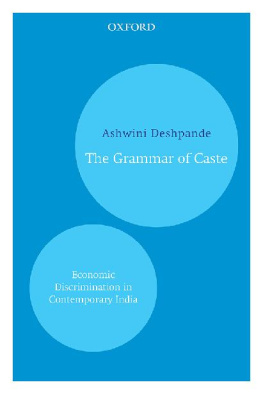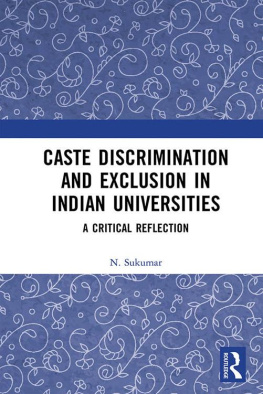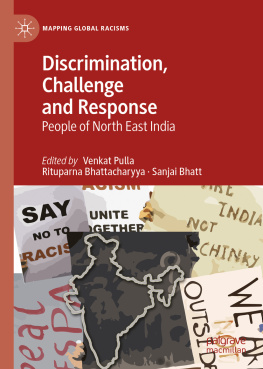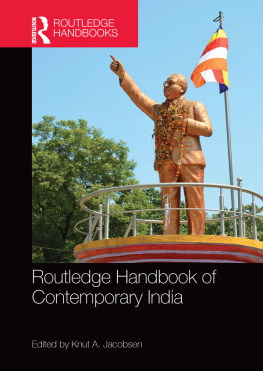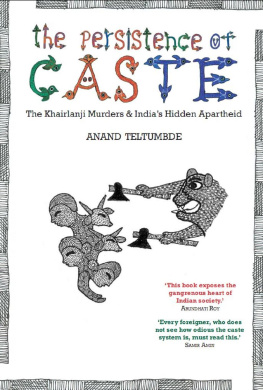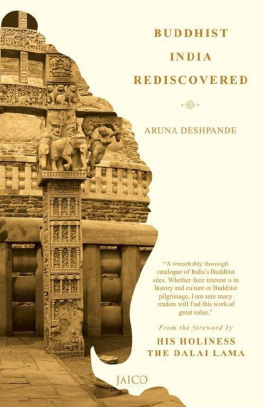THE GRAMMAR
OF CASTE
THE GRAMMAR
OF CASTE
Economic Discrimination
in Contemporary India
Ashwini Deshpande
Oxford University Press is a department of the University of Oxford.
It furthers the Universitys objective of excellence in research, scholarship,
and education by publishing worldwide. Oxford is a registered trademark of
Oxford University Press in the UK and in certain other countries
Published in India by
Oxford University Press
YMCA Library Building, 1 Jai Singh Road, New Delhi 110 001, India
Oxford University Press 2011
The moral rights of the author have been asserted
First published 2011
All rights reserved. No part of this publication may be reproduced, stored in
a retrieval system, or transmitted, in any form or by any means, without the
prior permission in writing of Oxford University Press, or as expressly permitted
by law, by licence, or under terms agreed with the appropriate reprographics
rights organization. Enquiries concerning reproduction outside the scope of the
above should be sent to the Rights Department, Oxford University Press,
at the address above
You must not circulate this work in any other form
and you must impose this same condition on any acquirer
ePub ISBN-13: 978-0-19-908846-1
ePub ISBN-10: 0-19-908846-2
Typeset in Lapidary 333 BT 11.5/13.3
by Eleven Arts, Keshav Puram, Delhi 110 035
Printed in India at Rakmo Press Pvt Ltd, New Delhi 110 020
In Aais memory, for Baba
Contents
TABLES
FIGURES
This book has been in the making for a while. Since it is appearing at a time when writings on caste are suddenly becoming plentiful, it is necessary to justify the existence of yet another book on the subject, especially when Oxford University Press has recently published an excellent collection of essays called Blocked by Caste , to which I too have contributed. While it is true that the literature on caste is vast, the bulk of it comes from sociology, political science, and history. There is still a dearth of economic analysis of caste disparity and discrimination. This book seeks to fill that gap and, in doing so, makes a number of useful interventions.
It addresses the larger community of all social scientists, economists included, because it integrates discussions on caste from other disciplines with those from within economics. Also, economics of discrimination is not a very mainstream sub-discipline within economics, so some of the material in this book is likely to be unfamiliar to economists as well. However, the discussion is deliberately non-technical so that it makes for easy reading; all the technical details can be followed up by those interested in doing so. The book reviews a wide range of the major theories of discrimination and caste from Indian theoreticians of caste such as Phule, Ambedkar, and Periyar to economic theorists models of discrimination, such as those contributed by Kenneth Arrow, Gary Becker, and George Akerlof. It brings together evidence on different dimensions of caste disparities based on two large national-level data sets in order to comment on the degree of change in the caste system over the last two decades. A lot of the evidence is based on my own research over the past decade, but I have also summarized most of the other available significant research. I have constructed a multifaceted Caste Development Index (CDI) that allows a broader assessment of standard of living of caste groups than what a narrow focus on income or consumption would allow. One can use this index to compare a caste group across states or time, and the gap between CDI values across caste groups can serve as a measure of disparity. I discuss the degree of continuity and change in caste disparities, and find that data point more towards continuation of traditional hierarchies rather than towards their dissolution, with upper castes at the top, Scheduled CastesScheduled Tribes at the bottom, and Other Backward Classes (OBCs) somewhere in between, with significant inter-state variation.
At first glance, this might seem like a restatement of traditional wisdom or a reinvention of the wheel. However, the dominant schools of thought today forcefully question the continuation of traditional hierarchies from a variety of perspectives. One perspective, predominantly from within sociology, argues that caste is dead or that hierarchy is replaced by competing equalities. Another perspective, predominantly from within a section of Dalit advocates, has suggested that liberalization and globalization of the Indian economy have unleashed forces that have upset, often obliterated, traditional caste distinctions. Thus, the evidence presented in this book, which is based on economic analysis, runs contrary to these views and does not reiterate traditional wisdom. The idea is to use the evidence presented in this book to acknowledge the gravity of the persistence of caste disparities, and to also recognize that contrary to wishful thinking, liberalization and a greater market orientation of the economy is not going to eliminate disparities on its own.
Measuring disparity is relatively straightforward; estimating discrimination is not. This is another area where economists have made important contributions. This book presents to the readers the latest set of methods that allow researchers to gauge discrimination and shows how some of these methods have been used in the Indian context and what that quest has yielded. What is very revealing is that lip-service to merit notwithstanding, contemporary, formal, urban sector labour markets show a deep awareness of caste, religious, gender, and class cleavages, and that discrimination is very much a modern sector phenomenon, perpetuated in the present. So it is neither a thing of the past nor confined only to the rural areas.
Finally, the book ends by discussing policy responses to disparities and discrimination with a review of the existing quota policy. I present the very latest research that shows, contrary again to popular belief, that affirmative action does not have adverse effects in employment and education. Given the multifaceted nature of deprivation, I argue that increasing quotas mechanically cannot be a solution to caste discrimination. Access to higher education and formal sector employment (which quotas address) is important and should be continued, but the lives of the majority of rural Dalits are untouched by this. It is important, therefore, to look beyond quotas. Increased access to productive assets, such as land, via land reforms, and to alternative sources of livelihoods, via generation of rural non-farm employment, is imperative. Also, in urban areas, we have to look beyond quotas and increase diversity in public spaces. Caste discrimination is clear and persistent, and needs targeted interventions.

.
To start on a trite note, there is a journey underlying every book. I do not intend to test your patience by recounting the vicissitudes of this particular journey, but would like to outline the broad course, essentially to acknowledge the invaluable role of several individuals without whom this journey would not have been completed.




